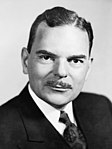| |||||||||||||||||||||||||||||
1,000 delegates to the Republican National Convention 501 (majority) votes needed to win | |||||||||||||||||||||||||||||
|---|---|---|---|---|---|---|---|---|---|---|---|---|---|---|---|---|---|---|---|---|---|---|---|---|---|---|---|---|---|
| |||||||||||||||||||||||||||||
| |||||||||||||||||||||||||||||
From March 12 to May 17, 1940, voters of the Republican Party chose delegates to nominate a candidate for president at the 1940 Republican National Convention. The nominee was selected at the convention in Philadelphia, Pennsylvania from June 24–28, 1940.[2]
The primaries were contested mainly by Manhattan District Attorney Thomas E. Dewey and Senators Robert A. Taft and Arthur Vandenberg, though only a few states' primaries featured two or more of these men.
By the start of the convention, only 300 of the 1,000 convention delegates had been pledged to a candidate, far fewer than was necessary to determine a victor. Estimates of delegate loyalty placed Dewey first, Taft second, and Wendell Willkie, an internationalist businessman, third.[1] Late momentum following the escalation of World War II allowed Willkie to take the nomination on the sixth ballot at the convention.
- ^ a b c d "Willkie Reported "Practical" on G.O.P. Patronage". Cincinnati Enquirer. 24 Jun 1940. Retrieved 17 Dec 2022.
- ^ Kalb, Deborah (2016-02-19). Guide to U.S. Elections - Google Books. ISBN 9781483380353. Retrieved 2016-02-19.
Cite error: There are <ref group=lower-alpha> tags or {{efn}} templates on this page, but the references will not show without a {{reflist|group=lower-alpha}} template or {{notelist}} template (see the help page).




